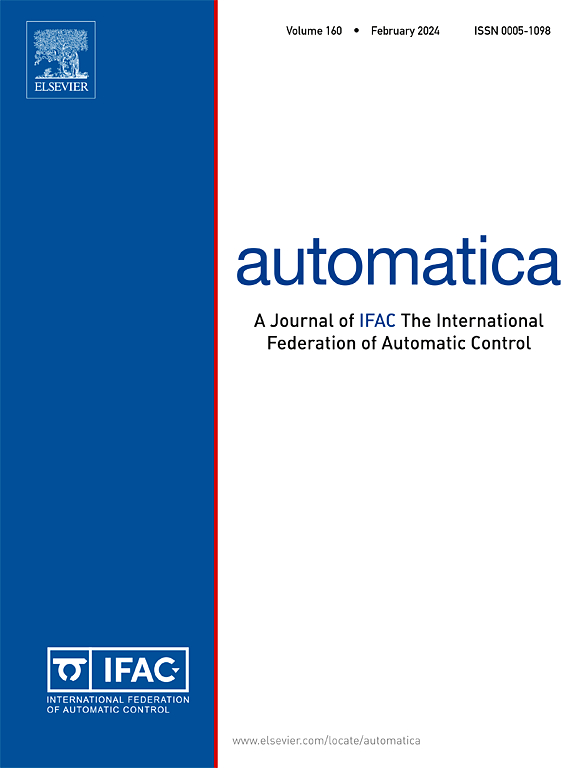具有可分配的安全集吸引率的局部实际安全极值求
IF 5.9
2区 计算机科学
Q1 AUTOMATION & CONTROL SYSTEMS
引用次数: 0
摘要
我们提出了可分配安全极值搜索(ASfES),这是一种算法,旨在最小化测量的静态目标函数,同时保持测量的静态安全度量(控制障碍函数或CBF)在实际意义上是正的。我们确保对于具有安全初始条件的轨迹,通过适当选择设计常数可以使对安全的违反任意小。我们还保证了一个可分配的“吸引”率:从不安全的初始条件,轨迹接近安全集,在测量CBF的意义上,以不慢于用户分配的速率。同样,从安全初始条件出发,轨迹接近不安全集,在CBF的意义上,不会比指定的吸引率更快。安全求极值的半全局版本不存在可分配吸引性的特征,其收敛的半全局是通过减缓自适应来实现的。我们还证明了参数局部收敛于具有线性CBF的安全集约束的二次目标函数的最小邻域。ASfES算法和分析是多变量的,但我们也将算法扩展到基于牛顿的ASfES方案,我们表明该方案仅在标量情况下有用。通过仿真算例说明了所设计方案的性能。本文章由计算机程序翻译,如有差异,请以英文原文为准。
Local practically safe extremum seeking with assignable rate of attractivity to the safe set
We present Assignably Safe Extremum Seeking (ASfES), an algorithm designed to minimize a measured, static objective function while maintaining a measured, static metric of safety (a control barrier function or CBF) to be positive in a practical sense. We ensure that for trajectories with safe initial conditions, the violation of safety can be made arbitrarily small through appropriately chosen design constants. We also guarantee an assignable “attractivity” rate: from unsafe initial conditions, the trajectories approach the safe set, in the sense of the measured CBF, at a rate no slower than a user-assigned rate. Similarly, from safe initial conditions, the trajectories approach the unsafe set, in the sense of the CBF, no faster than the assigned attractivity rate. The feature of assignable attractivity is not present in the semiglobal version of safe extremum seeking, where the semiglobality of convergence is achieved by slowing the adaptation. We also demonstrate local convergence of the parameter to a neighborhood of the minimum of a quadratic objective function constrained to the safe set with a linear CBF. The ASfES algorithm and analysis are multivariable, but we also extend the algorithm to a Newton-Based ASfES scheme which we show is only useful in the scalar case. The proven properties of the designs are illustrated through simulation examples.
求助全文
通过发布文献求助,成功后即可免费获取论文全文。
去求助
来源期刊

Automatica
工程技术-工程:电子与电气
CiteScore
10.70
自引率
7.80%
发文量
617
审稿时长
5 months
期刊介绍:
Automatica is a leading archival publication in the field of systems and control. The field encompasses today a broad set of areas and topics, and is thriving not only within itself but also in terms of its impact on other fields, such as communications, computers, biology, energy and economics. Since its inception in 1963, Automatica has kept abreast with the evolution of the field over the years, and has emerged as a leading publication driving the trends in the field.
After being founded in 1963, Automatica became a journal of the International Federation of Automatic Control (IFAC) in 1969. It features a characteristic blend of theoretical and applied papers of archival, lasting value, reporting cutting edge research results by authors across the globe. It features articles in distinct categories, including regular, brief and survey papers, technical communiqués, correspondence items, as well as reviews on published books of interest to the readership. It occasionally publishes special issues on emerging new topics or established mature topics of interest to a broad audience.
Automatica solicits original high-quality contributions in all the categories listed above, and in all areas of systems and control interpreted in a broad sense and evolving constantly. They may be submitted directly to a subject editor or to the Editor-in-Chief if not sure about the subject area. Editorial procedures in place assure careful, fair, and prompt handling of all submitted articles. Accepted papers appear in the journal in the shortest time feasible given production time constraints.
 求助内容:
求助内容: 应助结果提醒方式:
应助结果提醒方式:


